Bat Trang ceramics village, located on the left bank of the Red River and approximately 13 kilometers southeast of Hanoi, has gained widespread recognition as one of Vietnam’s most renowned tourist destinations. This charming village is celebrated for its exquisite pottery and porcelain products, making it an essential stop for art enthusiasts and culture seekers.
History of Bat Trang Ceramics
Origins of Bat Trang Ceramics
The history of Bat Trang ceramics dates back to the Ly dynasty, which reigned over Vietnam from the 11th to the 14th century. During this period, King Ly Thai To made the momentous decision to relocate the capital city from Hoa Lu to Thang Long (present-day Hanoi) in 1010. Along with the king’s entourage, a group of skilled potters from Bo Bat ceramics village in Ninh Binh province followed suit and settled in the surrounding area. Little did they know that their arrival would pave the way for the birth of Bat Trang ceramics.
As the potters explored their new surroundings, they stumbled upon an abundant supply of white clay in what is now known as Bat Trang village. Recognizing the potential of this precious resource, they wasted no time in establishing pottery kilns and setting up workshops to craft ceramic wares. Their dedication and ingenuity quickly transformed Bat Trang into a thriving ceramics hub.
The discovery of white clay in Bat Trang was a game-changer for the potters. White clay was highly sought after for its purity and excellent properties for ceramic production. It possessed the unique quality of being able to withstand high firing temperatures without warping or losing its shape, resulting in sturdy and long-lasting ceramic products.
The artisans of Bat Trang village capitalized on this advantage and began to produce a wide range of ceramic wares, including household items, religious artifacts, and decorative pieces. Their craftsmanship and attention to detail quickly gained recognition, and Bat Trang ceramics earned a reputation for their quality and beauty.
Development and Growth of the Craft Village
Bat Trang ceramics village began its humble journey as a local craft center, serving the needs of the capital city and nearby communities. However, word soon spread about the exceptional quality and craftsmanship of the ceramics produced in Bat Trang. The village’s reputation transcended its immediate surroundings, attracting attention from far and wide.
During the 15th and 16th centuries, Bat Trang ceramics experienced a significant breakthrough. It caught the eye of the imperial court, earning recognition as a supplier of ceramics to the royal household. This prestigious endorsement elevated Bat Trang’s status and brought it into the national spotlight. Not only did the village serve the needs of the royal family, but it also catered to the demands of neighboring regions.
The growing popularity of Bat Trang ceramics led to an expansion of production and diversification of products. The artisans of Bat Trang showcased their versatility and creativity, crafting a wide range of ceramic items to meet the evolving tastes and preferences of customers. From exquisite tableware and utilitarian vessels to decorative pieces that adorned palaces and temples, Bat Trang ceramics demonstrated their ability to blend functionality with artistic expression.
Throughout the centuries, Bat Trang ceramics village continued to flourish, preserving the traditional craft and adapting to changing times. The village became a beacon of artistic excellence, attracting scholars, connoisseurs, and traders who recognized the value and beauty of Bat Trang ceramics. It played a vital role in shaping the cultural landscape of Vietnam, with its ceramics becoming an integral part of the nation’s heritage.
Today, Bat Trang ceramics village stands as a testament to the enduring legacy of its artisans. The meticulous techniques and exquisite designs passed down from generation to generation continue to captivate enthusiasts and collectors. Visitors to Bat Trang have the opportunity to witness the age-old tradition of ceramic making, immersing themselves in the rich history and cultural significance of this vibrant craft village.
As Bat Trang embraces the challenges of the modern world, efforts are being made to preserve and promote the art of ceramics. The government, artisans, and local communities are joining forces to safeguard the traditional techniques, provide training opportunities for the younger generation, and create platforms for artisans to showcase their skills and creativity.
Bat Trang ceramics village remains a testament to the resilience and ingenuity of Vietnam’s artisans. It stands as a living museum, where the past converges with the present, and the beauty of handmade ceramics continues to inspire and enchant.
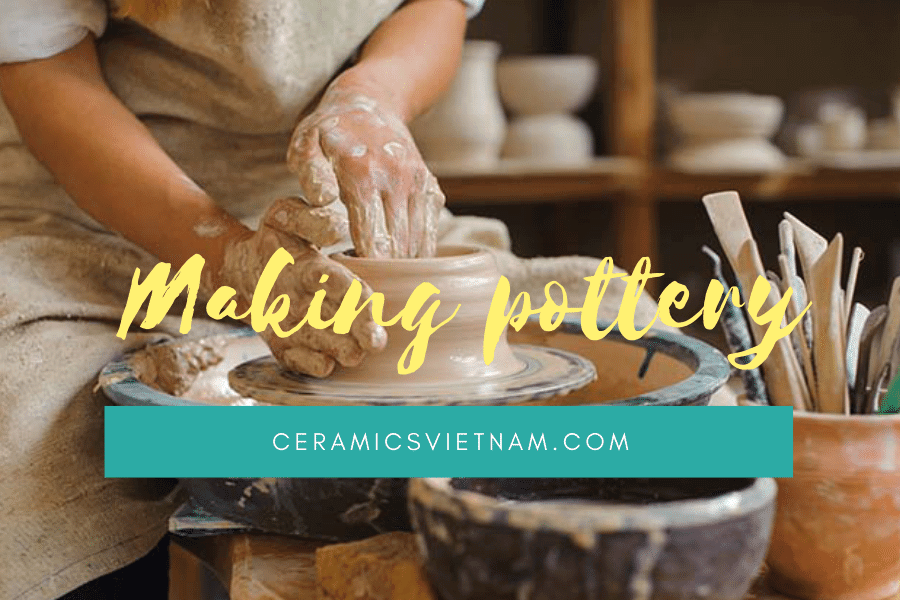
Traditional Ceramic Making Process in Bat Trang Village
The Traditional Ceramic Making Process
Preparing Raw Materials
The first step in the ceramic making process is the careful preparation of raw materials, specifically clay and glaze. While local clay deposits in Bat Trang have diminished over time, potters now source clay from neighboring regions along the Red River. The clay undergoes a rigorous process of blending and refining to eliminate impurities and achieve the desired consistency.
To prepare the clay, artisans follow a series of meticulous steps. First, the raw clay is carefully selected and collected from nearby locations renowned for their high-quality clay deposits. Once the clay is gathered, it is left to dry and harden to make it easier to work with.
Next, the dried clay is crushed and ground into fine particles. This process ensures a consistent texture and removes any impurities or debris that may be present in the raw clay. The finely ground clay is then sifted through fine mesh screens to further refine its texture and remove any remaining impurities.
After the clay has been sifted, it is mixed with water to create a slurry. The slurry is thoroughly stirred to achieve a homogenous mixture and to ensure that all clay particles are evenly dispersed in the water. This step is crucial for achieving the desired plasticity and workability of the clay.
To further enhance the properties of the clay, additives may be incorporated into the mixture. These additives can include sand, feldspar, or other minerals that contribute to the clay’s stability, strength, and firing characteristics. The specific composition of the clay mixture may vary depending on the desired qualities of the final ceramic product.
Once the clay has been thoroughly mixed, it undergoes a maturing process. This involves allowing the clay to rest and age for a specific period, typically several weeks or months. During this maturing period, the clay gradually becomes more pliable and easier to work with. Maturing also allows the clay to stabilize and develop the desired properties for successful firing.
While the clay is maturing, the potters focus on preparing the glaze. Glaze ingredients are meticulously selected based on their desired properties, including color, texture, and melting point. These ingredients, such as minerals, oxides, and fluxing agents, are carefully measured and mixed according to specific recipes and formulas that have been refined over generations.
The glaze ingredients are ground into a fine powder and then mixed with water to create a glaze slurry. This slurry is thoroughly stirred to ensure that all components are well-dissolved and evenly distributed. The glaze slurry is left to settle, allowing any heavy particles to sink to the bottom and the desired colloidal particles to remain suspended in the liquid. This settling process helps achieve a consistent and uniform application of the glaze onto the ceramic surface.
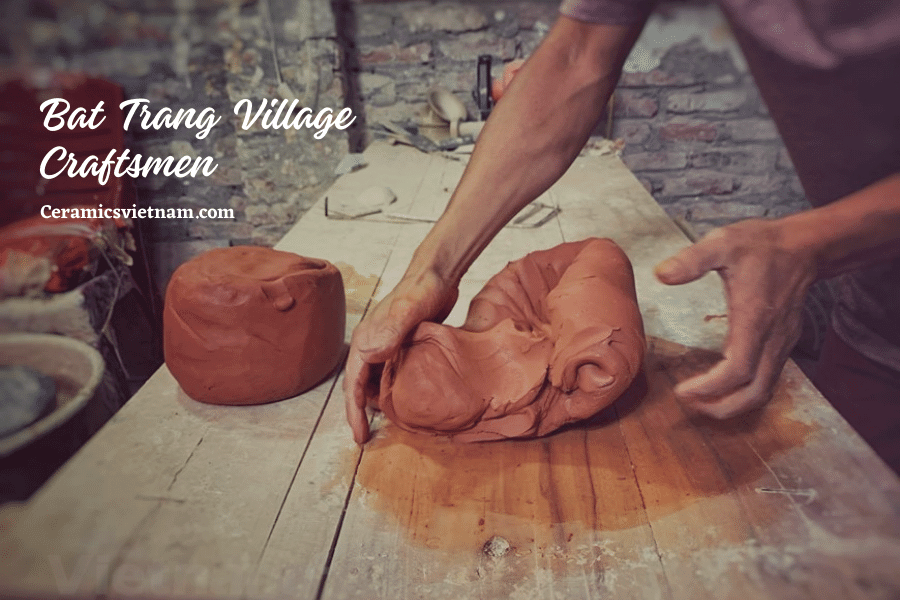
Traditional Ceramic Making Process in Bat Trang Village
Shaping Clay
Bat Trang potters employ the throwing technique to shape clay into desired forms. This technique requires exceptional skill and precision, as the potter uses their hands to manipulate the clay while the wheel spins. The process begins with a lump of thoroughly wedged clay, which is placed centrally on a foot-operated wheel.
As the wheel turns, the potter applies controlled pressure with their hands and fingers to shape the clay. The potter’s dexterity and experience play a crucial role in creating symmetrical and well-proportioned forms. They carefully control the speed of the wheel and adjust the pressure applied to the clay to achieve the desired shape.
During the shaping process, various tools are used to refine the clay and perfect its form. Pottery ribs, made of wood or metal, are instrumental in smoothing the clay’s surface, removing excess material, and creating elegant curves. The potter skillfully guides the ribs along the surface of the clay, ensuring a smooth and even shape.
To separate the shaped piece from the wheel, wires or cutting tools are employed. The potter carefully cuts through the base of the clay form, allowing it to be lifted without distorting its shape. This delicate process requires precision and a steady hand to avoid any damage or deformation to the piece.
Once shaped, the greenware—referring to the clay pieces that have been shaped but have not yet undergone firing—is set aside to dry. The drying process is critical as it allows the clay to reach a leather-hard stage. During this stage, the clay is firm enough to be handled without losing its shape. It becomes less susceptible to deformation and more resistant to cracks during further processing.
Artisans meticulously work on the leather-hard greenware to refine and enhance its appearance. They carefully trim the edges, removing any uneven or excess clay to achieve clean lines and smooth surfaces. Any imperfections or rough spots are smoothed out using specialized tools and techniques. The artisans pay great attention to detail, ensuring that every surface is uniform and visually pleasing.
In addition to refining the shape, artisans may also add decorative elements at this stage. Handles, spouts, or other attachments may be carefully attached to the clay form, ensuring that they blend harmoniously with the overall design. These additions not only contribute to the aesthetic appeal of the ceramics but also enhance their functionality.
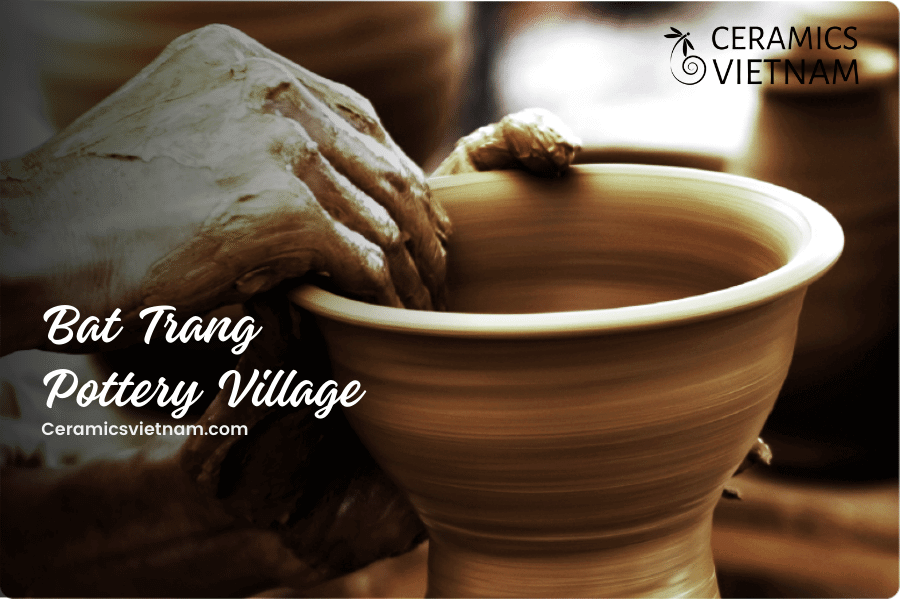
Traditional Ceramic Making Process in Bat Trang Village
Decorating and Glazing
Decoration is an essential aspect of Bat Trang ceramics, elevating them to exquisite works of art. The artisans of Bat Trang employ a wide range of techniques to embellish their creations, showcasing their creativity, skill, and attention to detail.
One popular method used by Bat Trang potters is the application of color or colored glazes. Using specialized brushes, the artisans carefully apply these glazes to the surface of the ceramics, creating visually striking patterns and designs. The colors used in the glazes can vary greatly, ranging from vibrant and bold hues to subtle and delicate shades. This diversity of colors allows the artisans to express their artistic vision and pay homage to the rich cultural heritage of Vietnam.
The designs found on Bat Trang ceramics are often inspired by nature, traditional symbols, or abstract motifs. Delicate floral patterns, intricate geometric arrangements, and stylized representations of animals or mythical creatures are commonly featured. These designs are meticulously painted onto the ceramics with precision and attention to detail, transforming them into captivating visual narratives.
In addition to painting, Bat Trang artisans also employ embossing techniques to create texture and depth on the surface of the ceramics. By impressing patterns and motifs onto the clay, they add tactile interest and further enhance the visual appeal of the pieces. The embossed designs can depict a wide range of subjects, including traditional Vietnamese symbols, scenes from nature, or abstract geometrical patterns. Each embossed element is carefully executed, reflecting the artisans’ mastery of this intricate technique.
Glazing is a vital step in the ceramic making process, serving both aesthetic and functional purposes. The application of glaze enhances the appearance of the ceramics, providing them with a smooth and glossy finish. This lustrous surface accentuates the colors and designs, making them more vibrant and visually appealing.
Moreover, the glaze layer acts as a protective barrier for the ceramics. It enhances their durability, making them more resistant to wear, staining, and water absorption. The interaction between the glaze and the clay body during the firing process results in a fusion that ensures the glaze remains securely attached to the ceramic surface.
To apply glaze, Bat Trang artisans utilize various methods depending on the size and shape of the ceramics. For smaller pieces, they may dip them into a glaze bath, ensuring even coverage and consistent color distribution. Larger and more intricate pieces are often brushed with glaze, allowing the artisans greater control over the application and design. This brushwork technique allows for precise detailing and the creation of unique effects.
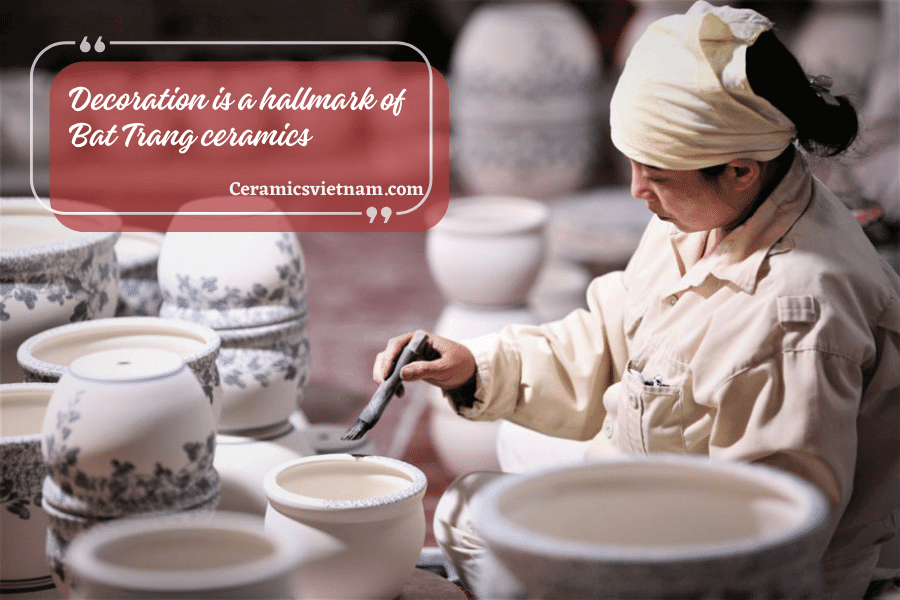
Traditional Ceramic Making Process in Bat Trang Village
Firing
Firing is the transformative stage that brings the ceramics to life. Traditionally, Bat Trang potters used wood or dust coal-fueled kilns, each with its unique structure and firing techniques. Today, modern gas or electric kilns are also used, providing more precise temperature control.
The firing process is carefully controlled to ensure the ceramics reach their optimal strength and appearance. The kilns are loaded with the greenware, and the firing cycle begins. The temperature is gradually increased, allowing the ceramics to undergo physical and chemical changes. At lower temperatures, any remaining moisture is driven out of the ceramics, preventing cracking or exploding during the subsequent high-temperature firing.
As the kiln temperature rises, the clay particles undergo chemical reactions, transforming into a solid, vitrified ceramic material. The glaze layer melts and fuses with the clay body, creating a smooth, glassy surface. The firing process reaches its peak temperature, typically exceeding 1,000 degrees Celsius, before gradually cooling down.
The cooling process is equally important, as it allows the ceramics to gradually adjust to room temperature, minimizing the risk of cracking due to thermal shock. Once the kiln has cooled sufficiently, the finished ceramics are carefully removed, revealing the final results of the arduous ceramic making process.
By adhering to this traditional four-step process, Bat Trang artisans preserve the rich heritage of ceramic making and create timeless pieces that continue to captivate audiences worldwide. The combination of skilled craftsmanship, meticulous attention to detail, and the transformative power of firing results in Bat Trang ceramics that are not only visually stunning but also durable and long-lasting.
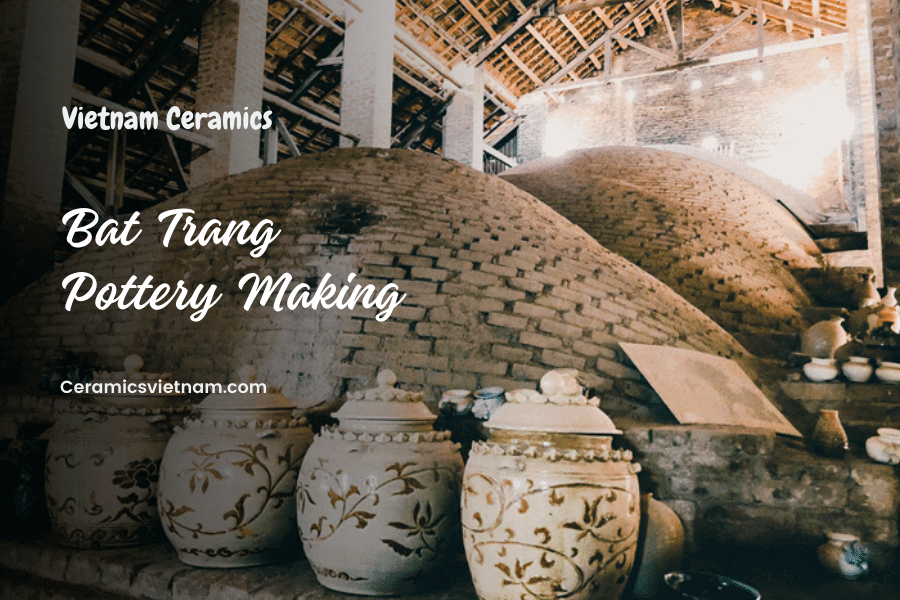
Traditional Ceramic Making Process in Bat Trang Village
Role of Artisans in Bat Trang
The artisans of Bat Trang play a vital role in upholding and advancing the traditional ceramic making process. With their exceptional skills and expertise, they contribute to the exquisite quality and craftsmanship that define Bat Trang ceramics.
Skills and Expertise of the Artisans
The artisans undergo extensive training and apprenticeships to acquire the necessary skills for each stage of the ceramic making process. They possess a deep understanding of the properties of different types of clay and the art of blending them to achieve the perfect consistency. With their deft hands, they skillfully shape clay on the wheel, creating symmetrical and well-proportioned ceramic pieces.
Decorating ceramics requires a keen eye for detail and a steady hand. The artisans of Bat Trang have mastered various techniques, including hand-painting intricate patterns, embossing delicate designs, and applying glazes to enhance the aesthetic appeal of their creations. Their artistic sensibilities, combined with their technical expertise, result in visually captivating ceramic pieces that showcase their mastery of the craft.
The artisans’ dedication to their work is evident in their meticulous attention to detail and their ability to consistently produce high-quality ceramics. They possess a deep knowledge of traditional techniques and employ them with precision and finesse, ensuring that each piece meets the exacting standards that Bat Trang ceramics are renowned for.

Role of Artisans in Bat Trang
Transfer of Knowledge Through Generations
The knowledge and techniques of ceramic making in Bat Trang have been passed down through generations within artisan families. This transfer of knowledge ensures the continuity and preservation of the traditional craft, safeguarding its authenticity and cultural significance.
Young artisans embark on apprenticeships under the guidance of experienced master craftsmen. They learn the secrets of clay preparation, shaping techniques, decoration methods, and firing processes directly from their predecessors. Through years of hands-on training and observation, the younger generation acquires the necessary skills and develops their artistic sensibilities.
The apprenticeship system not only imparts technical expertise but also instills a deep understanding and appreciation for the cultural heritage associated with Bat Trang ceramics. As the artisans grow and mature in their craft, they add their own creative flair and innovations while staying true to the essence of the traditional techniques.
This transfer of knowledge through generations ensures the continuity and evolution of the art of ceramic making in Bat Trang. It preserves the rich cultural legacy of the craft while allowing for adaptation to contemporary demands and trends. The combination of traditional knowledge and the fresh perspectives of the younger generation keeps the craft alive and relevant in today’s world.
The dedication, skill, and passion of the artisans are instrumental in keeping the tradition of Bat Trang ceramics alive and thriving. Their expertise and commitment to the craft contribute to the exceptional quality and artistic value of the ceramics produced in the village. Through their artistry, the artisans of Bat Trang continue to inspire and captivate audiences, preserving the legacy of this timeless art form for future generations.

Role of Artisans in Bat Trang
Unique Characteristics of Bat Trang Ceramics
Intricate Designs and Patterns
Bat Trang ceramics are renowned for their intricate designs and patterns, showcasing the artistic mastery of the artisans. Each piece is a testament to the craftsmanship and creativity of the potters, who skillfully incorporate intricate motifs onto the ceramics.
The designs found in Bat Trang ceramics are diverse and captivating. Floral patterns, inspired by the natural beauty of Vietnam, are delicately hand-painted onto the ceramics. Traditional Vietnamese symbols, such as dragons, phoenixes, and lotus flowers, are often incorporated, representing cultural values and beliefs. Geometric patterns, inspired by ancient architectural designs, add a modern touch to the ceramics.
The artisans of Bat Trang possess a keen eye for detail and employ various techniques to bring their designs to life. Whether it’s through meticulous brushwork, precise carving, or intricate embossing, each ceramic piece reflects the time and effort dedicated to its creation. The intricate designs of Bat Trang ceramics not only enhance their aesthetic appeal but also serve as a testament to the rich artistic heritage of Vietnam.
High-Quality Materials and Craftsmanship
Bat Trang ceramics are crafted using high-quality materials, ensuring their durability and longevity. The artisans pay careful attention to the selection of clay and glaze ingredients, sourcing the finest materials available. The clay is carefully prepared and refined to remove impurities, resulting in a smooth and workable medium. The glazes are meticulously formulated to achieve the desired colors and finishes.
The craftsmanship of the artisans is evident in every step of the ceramic making process. From shaping the clay on the potter’s wheel to applying glaze and decorating the surface, the artisans display precision and skill. They employ traditional techniques that have been passed down through generations, using their hands and simple tools to create exquisite ceramic pieces. The attention to detail, combined with years of experience, results in flawless finishes and impeccable craftsmanship.
The use of high-quality materials and the artisans’ dedication to craftsmanship ensure that Bat Trang ceramics not only possess aesthetic beauty but also exhibit durability and functionality. These ceramics can withstand daily use and maintain their quality over time, making them cherished pieces that can be passed down through generations.

Unique Characteristics of Bat Trang Ceramics
Wide Range of Ceramic Products
Bat Trang ceramics village offers a wide range of ceramic products, catering to diverse tastes and purposes. From functional crockery such as plates, bowls, and teapots to decorative items like vases, figurines, and lanterns, there is something to suit every need and preference.
The artisans of Bat Trang continuously innovate and diversify their product offerings, incorporating contemporary designs and embracing modern trends while staying true to the traditional techniques. They experiment with new forms, colors, and textures, pushing the boundaries of ceramic artistry. This commitment to innovation ensures that Bat Trang ceramics remain relevant and appealing to a broad audience.
Bat Trang ceramics also find their place in ceremonial objects and architectural decorations. Intricately designed tiles and reliefs adorn temples, pagodas, and historical buildings, adding a touch of elegance and cultural significance to these structures. The versatility of Bat Trang ceramics allows them to transcend their functional and decorative aspects, becoming integral parts of Vietnam’s cultural and architectural heritage.
The unique characteristics of Bat Trang ceramics, from the intricate designs and patterns to the high-quality materials and craftsmanship, make them highly sought after and treasured by collectors, art enthusiasts, and those seeking to bring a touch of Vietnamese culture and beauty into their homes. Through their artistry, the artisans of Bat Trang continue to preserve and promote the rich cultural heritage of Vietnam, creating timeless ceramic pieces that capture the essence of this vibrant craft village.
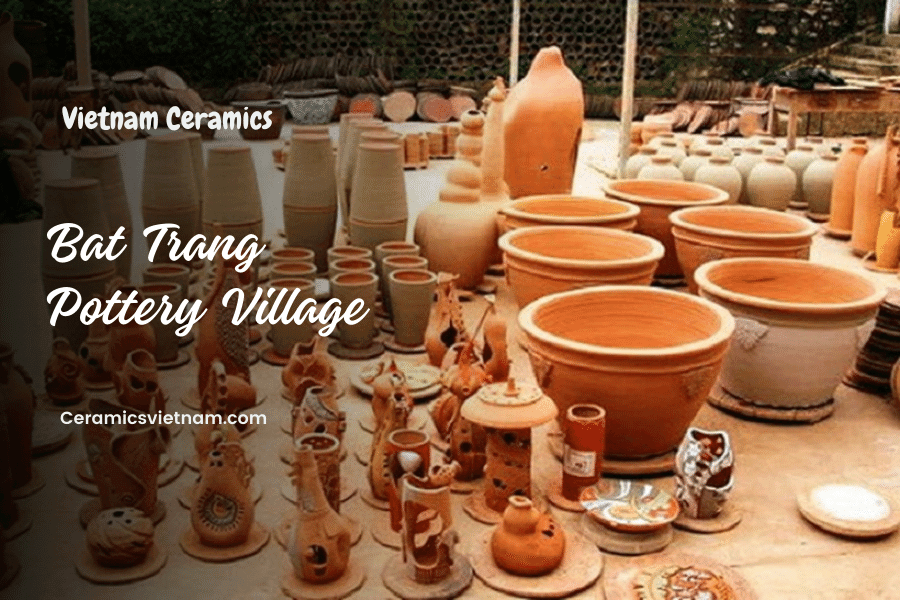
Unique Characteristics of Bat Trang Ceramics
Economic Impact and Tourism
Local Economy and Job Opportunities
Bat Trang ceramics village plays a significant role in the local economy, providing employment opportunities and contributing to the financial well-being of the community. The craft has been passed down through generations, sustaining the livelihoods of countless families in the village.
The production of Bat Trang ceramics involves a wide range of skilled artisans, including potters, painters, glazers, and kiln operators. These craftsmen and craftswomen dedicate their expertise and time to create exquisite ceramics that capture the essence of Vietnamese culture. The demand for Bat Trang ceramics generates a constant stream of income for these artisans and supports their families.
Moreover, the ceramics industry in Bat Trang has a multiplier effect on the local economy. It creates a network of suppliers who provide raw materials, equipment, and transportation services. Additionally, the village attracts other supporting businesses such as retailers, wholesalers, and hospitality establishments that cater to the needs of visitors and tourists.
Attraction for Domestic and International Tourists
Bat Trang ceramics village has emerged as a sought-after tourist destination, both for domestic and international visitors. The village’s rich cultural heritage, coupled with its exquisite ceramics, draws crowds of art enthusiasts, history buffs, and curious travelers.
Domestic tourists, in particular, flock to Bat Trang to explore their country’s traditional craft and take pride in its cultural significance. They appreciate the opportunity to witness the skillful artisans in action, observe the intricate process of ceramic making, and engage with the vibrant local community.
International tourists, on the other hand, are captivated by the unique charm and beauty of Bat Trang ceramics. They are drawn to the village’s reputation for producing high-quality, handmade ceramics that bear the mark of Vietnamese craftsmanship. Visitors from around the world relish the chance to acquire these authentic pieces, enriching their homes and collections with a touch of Vietnam’s artistic heritage.
The influx of tourists into Bat Trang brings about economic benefits for the community. Visitors contribute to the local economy by purchasing ceramics directly from the artisans, exploring the village’s craft shops, and enjoying local culinary delights. The revenue generated from tourism bolsters the village’s infrastructure, supports cultural preservation efforts, and fosters further growth and development.
In turn, the increasing popularity of Bat Trang as a tourist destination has spurred the establishment of museums, workshops, and exhibitions dedicated to showcasing the village’s rich history and ceramic-making traditions. These initiatives not only enrich the visitor experience but also promote a deeper understanding and appreciation of Bat Trang’s cultural legacy.
Bat Trang ceramics village serves as a shining example of how traditional crafts can drive economic growth, create job opportunities, and attract tourism. The interplay between the local economy and the village’s cultural heritage ensures the preservation and continuation of Bat Trang’s centuries-old ceramics tradition. As the village welcomes an ever-growing number of visitors, its unique charm and artistic treasures continue to leave a lasting impression on all who venture into its vibrant streets.

Bat Trang ceramics village has emerged as a sought-after tourist destination
Challenges and Future Prospects
Competition from Mass-Produced Ceramics
Bat Trang ceramics village faces a formidable challenge in the form of mass-produced ceramics that flood the market. These factory-made ceramics prioritize efficiency and cost-effectiveness, often at the expense of artistic craftsmanship. While these mass-produced ceramics may offer affordability and convenience, they lack the intricate designs, unique patterns, and individuality that define Bat Trang ceramics.
One of the distinguishing factors of Bat Trang ceramics is the personal touch of the artisans who infuse their creations with years of experience and artistic finesse. Each piece tells a story and bears the mark of the skilled hands that shaped it. In contrast, mass-produced ceramics lack this human touch, often appearing generic and devoid of the soul that emanates from handmade ceramics.
However, it is crucial to strike a delicate balance between preserving the traditional craft of Bat Trang and meeting the demands of the modern market. While the allure of mass-produced ceramics cannot be denied, there is an ongoing appreciation for authentic, handcrafted pieces that carry a sense of history and cultural heritage. This has created a niche market for Bat Trang ceramics, attracting discerning customers who value the artistry and uniqueness that only handmade ceramics can provide.
To thrive amidst competition, Bat Trang ceramics village must leverage its strengths and differentiate itself from mass-produced alternatives. Emphasizing the exceptional craftsmanship, intricate designs, and rich cultural heritage embedded in each piece will help Bat Trang ceramics stand out in the market. By highlighting the unique value of handmade ceramics and educating consumers about the significance of supporting traditional crafts, Bat Trang can foster an appreciation for its distinctive offerings.
Efforts to Preserve and Promote the Craft
Recognizing the importance of preserving this cultural heritage, various initiatives have been undertaken to promote and safeguard the craft of Bat Trang ceramics. The government plays a crucial role in providing support and resources to ensure the continued existence of the village as a vibrant center for ceramic making.
Training programs and workshops are organized to pass on the knowledge and skills of ceramic making to younger generations. Artisans receive guidance and support to improve their techniques, explore new design possibilities, and adapt to changing consumer preferences. These efforts empower the artisans to innovate while staying true to the essence of Bat Trang ceramics.
Exhibitions and cultural events are organized to showcase the beauty and uniqueness of Bat Trang ceramics to both domestic and international audiences. These platforms not only increase awareness of the craft but also create opportunities for artisans to connect with potential buyers and expand their market reach.
Marketing campaigns, both traditional and digital, are employed to promote the value and authenticity of Bat Trang ceramics. By highlighting the rich cultural heritage, meticulous craftsmanship, and unique characteristics of the ceramics, these campaigns aim to differentiate Bat Trang ceramics from mass-produced alternatives.
Collaborations between artisans, designers, and entrepreneurs are fostering innovation and creating new avenues for the growth of Bat Trang ceramics. By incorporating contemporary designs, exploring sustainable practices, and expanding product lines, Bat Trang ceramics are adapting to the evolving market landscape while preserving their traditional essence.
With these concerted efforts to preserve and promote the craft, the future prospects for Bat Trang ceramics are promising. The continued support from the government, the passion and dedication of the artisans, and the growing appreciation for authentic handmade crafts contribute to the sustainability and growth of Bat Trang ceramics as a cultural treasure.
Despite the challenges, the timeless beauty, exceptional quality, and cultural significance of Bat Trang ceramics continue to captivate audiences worldwide. By embracing innovation while staying rooted in tradition, Bat Trang ceramics village remains a symbol of Vietnam’s rich artistic heritage.

Bat Trang ceramics village faces a formidable challenge
Conclusion
The art of making ceramics in Bat Trang traditional craft village is a testament to the skill, creativity, and dedication of the artisans. The meticulous process, from preparing raw materials to firing the ceramics, ensures the production of exceptional pieces. Bat Trang ceramics hold immense cultural significance, attracting visitors from around the world to witness this timeless art form. By preserving and promoting the craft, Bat Trang continues to be a symbol of Vietnam’s rich heritage.
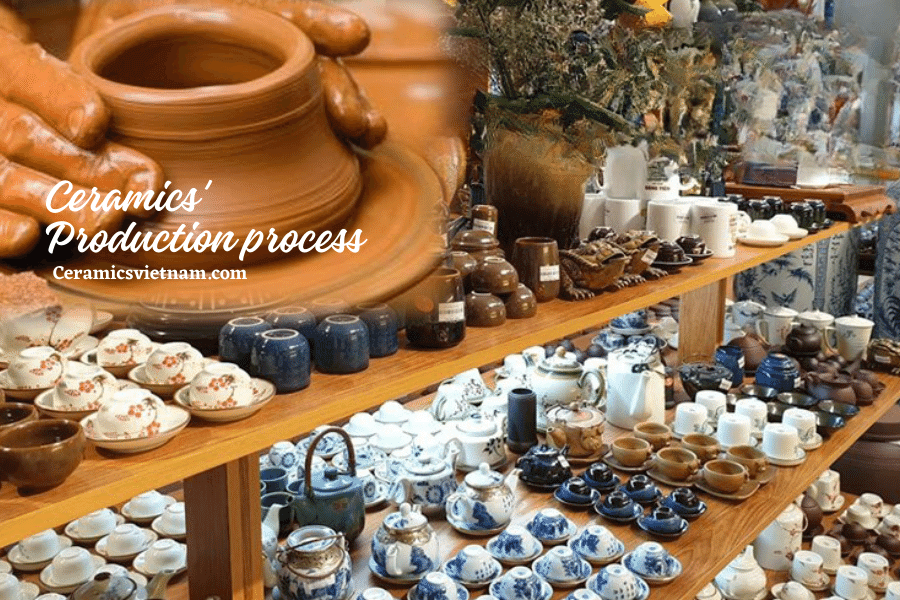
Traditional Ceramic Making Process in Bat Trang Village
FAQs
1. How old is Bat Trang ceramics village? Bat Trang ceramics village dates back to the Ly dynasty and has a history of over 600 years.
2. What distinguishes Bat Trang ceramics from other traditional ceramics villages? Bat Trang ceramics are characterized by embossed decoration and ivory-white crackle glaze, setting them apart from products made in other villages.
3. What techniques are used for decorating ceramics in Bat Trang? Bat Trang potters employ various techniques, including coloring, embossing, and brushwork, to decorate their ceramics.
4. What challenges does Bat Trang ceramics village face? Bat Trang ceramics village faces challenges from mass-produced ceramics. Efforts are being made to raise awareness and promote the authenticity and value of Bat Trang ceramics.
5. How is Bat Trang ceramics village preserving its heritage? Bat Trang ceramics village receives support from the government, with initiatives such as training programs, exhibitions, and marketing campaigns aimed at preserving and promoting the craft.














Leave a reply